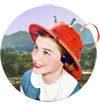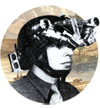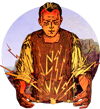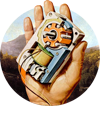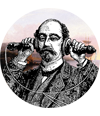The museum might not have walls, but it's got some stories...
Categories:
 When people ask me (as they inevitably do when they find out I'm a full time volunteer) why I do VISTA, I often cite the ways it connects me to groups and people that I could have never imagined I could meet doing a regular job. In fact, my work this year doing digital storytelling facilitation and other related projects for MassIMPACT came out of meeting Natasha Friedus (of Creative Narrations) at UMass Boston and getting myself invited to her second Spreading the Stories train-the-trainer workshop last year. And so it was how I ended up at the MIT Museum this past week, working with able fellow facilitator Lisa Dush of Story Builders, UMass Amherst, and MIT in the fall. We were asked by Cesar McDowell of MIT's Center for Reflective Community Practice to help out with the new Museum Without Walls project.
When people ask me (as they inevitably do when they find out I'm a full time volunteer) why I do VISTA, I often cite the ways it connects me to groups and people that I could have never imagined I could meet doing a regular job. In fact, my work this year doing digital storytelling facilitation and other related projects for MassIMPACT came out of meeting Natasha Friedus (of Creative Narrations) at UMass Boston and getting myself invited to her second Spreading the Stories train-the-trainer workshop last year. And so it was how I ended up at the MIT Museum this past week, working with able fellow facilitator Lisa Dush of Story Builders, UMass Amherst, and MIT in the fall. We were asked by Cesar McDowell of MIT's Center for Reflective Community Practice to help out with the new Museum Without Walls project.
Museum Without Walls (MWOW) is an interesting approach to bringing the museum experience out of the museum, approaching the entire MIT campus like a potential historical and personal tour and reflection space. Using adapted video players with WIFI access and GPS, the project aspires to have visitors walk the campus and access a rich library of video and still content based on their physical location by 2011. Since it's MIT, the gadgets will certainly be innovative and the stories unique, but the interdisciplinary idea of museum content that could change as users add and walk around with it piqued my personal interest in placed based storytelling.
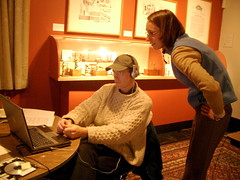 Our small digital storytelling workshop was billed not only as a pilot to create MIT place based stories, but as a Independent Activities Period (IAP) offering. (I learned later through one of the stories that this is a way for MIT students and staff to explore small subject explorations in the time between fall and spring semesters.) We set up a workspace in a long exhibit space, so that our story circle and laptop workspaces were surrounded by antique single lensed microscopes. In fact, this full immersion in the to Museum became a quiet theme to the week, where we were invited into the archives to find images and I passed by Harold Edgerton photos and holographs on my way to the bathroom.
Our small digital storytelling workshop was billed not only as a pilot to create MIT place based stories, but as a Independent Activities Period (IAP) offering. (I learned later through one of the stories that this is a way for MIT students and staff to explore small subject explorations in the time between fall and spring semesters.) We set up a workspace in a long exhibit space, so that our story circle and laptop workspaces were surrounded by antique single lensed microscopes. In fact, this full immersion in the to Museum became a quiet theme to the week, where we were invited into the archives to find images and I passed by Harold Edgerton photos and holographs on my way to the bathroom.
Our host Otto Loggers gathered a group of graduate students from the HASTS (History, Anthropology, and Science, Technology & Society), Urban Planning, and Biology programs, sprinkled in with a staff from the Alumni office. In the beginning, Lisa and I were curious on how we could balance the desire to include historical references and facts with authentic narratives usually characterized in digital stories. The fear is always that participants will lean toward professional, objective tales and away from more personal stories, but this group also had the challenge of being the pilot stories in the MWOW project. We decided to go with the flow and see where the participants' stories and group's dynamics took us.

 I'm glad to report that the group came together well, still bringing a myriad of tones, purposes, and expressions. While one PhD student mused why MIT isn't more focused on environmental sustainability, another detailed her participation on huge, puzzle riddled annual Mystery Hunt. Another student candidly discussed her emotions around being an Iranian student at MIT and shared a table with fellow HAST student who hysterically chronicled her initial days of getting hopelessly lost in the maze of MIT's buildings. One story even connected MIT to Lawrence and Lowell through past funders and current initiatives. Even the stories about alumni and IAP featured personal touches such as famous crimson red jacket and a "borrowed" sign warning of laser beams. (As soon at the stories come out of post-production and the MWOW folks figure out next steps of getting the pieces online, I'll include a link here.)
I'm glad to report that the group came together well, still bringing a myriad of tones, purposes, and expressions. While one PhD student mused why MIT isn't more focused on environmental sustainability, another detailed her participation on huge, puzzle riddled annual Mystery Hunt. Another student candidly discussed her emotions around being an Iranian student at MIT and shared a table with fellow HAST student who hysterically chronicled her initial days of getting hopelessly lost in the maze of MIT's buildings. One story even connected MIT to Lawrence and Lowell through past funders and current initiatives. Even the stories about alumni and IAP featured personal touches such as famous crimson red jacket and a "borrowed" sign warning of laser beams. (As soon at the stories come out of post-production and the MWOW folks figure out next steps of getting the pieces online, I'll include a link here.)
 The usual stress of learning a new form of expression coupled with new technologies was a bit increased when we learned that most of the participants were Mac folks and we were confined to the Windows laptops we were able to procure. But I always make the argument that the stories can be made with even the most rudimentary tools and keeping it simple never hurts. So even when Windows Movie Maker crashed and the participants started to perfect the Day 3 hunch over their machines, I told them to be patient, stretch and take breaks, and save often (Ctrl S is your friend). In three days, they not only made seven 3-5 minutes long digital stories, Lisa introduced the group to audio editing in Audacity and we managed to scan quite a few photos and artifacts for both the stories and the Museum's digital archives as well.
The usual stress of learning a new form of expression coupled with new technologies was a bit increased when we learned that most of the participants were Mac folks and we were confined to the Windows laptops we were able to procure. But I always make the argument that the stories can be made with even the most rudimentary tools and keeping it simple never hurts. So even when Windows Movie Maker crashed and the participants started to perfect the Day 3 hunch over their machines, I told them to be patient, stretch and take breaks, and save often (Ctrl S is your friend). In three days, they not only made seven 3-5 minutes long digital stories, Lisa introduced the group to audio editing in Audacity and we managed to scan quite a few photos and artifacts for both the stories and the Museum's digital archives as well.
In a stroke of luck, we invited the Museum staff that had opened the doors for us or researched our topics in the archives to come see the finished pieces. I say this was lucky because they were such a gracious and appreciative audience - especially friend Adam Holt who's excited about the possibilities of this project to combine digital storytelling and mapping. These staff had seen us around the last three days, but they had no idea that we were working on such "gems" of MIT's history funneled through personal experience. After a frazzled afternoon of harried video editing, these compliments soothed our storytellers and got them thinking about how they could take digital storytelling back to their departments and projects as the next semester begins this week.
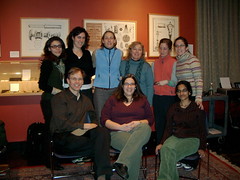 This workshop was a good break for me from working with youth or community organizers, strictly because the mind sets seemed so different. MIT students seem strangely focused on their individual studies and programs yet still connected with so many aspects of the world and the environment. By throwing a personal narrative process into this mix, Lisa and I created a space that yielded new challenges and benefits for me as a facilitator. The juxtaposition of the microscopic and global mind sets created a compelling challenge as we revised the stories based on the perceived audience and intended point of view. And the idea that personal reflection should be tempered with historical and archival facts and context both limited and expanded the impact of each story differently.
This workshop was a good break for me from working with youth or community organizers, strictly because the mind sets seemed so different. MIT students seem strangely focused on their individual studies and programs yet still connected with so many aspects of the world and the environment. By throwing a personal narrative process into this mix, Lisa and I created a space that yielded new challenges and benefits for me as a facilitator. The juxtaposition of the microscopic and global mind sets created a compelling challenge as we revised the stories based on the perceived audience and intended point of view. And the idea that personal reflection should be tempered with historical and archival facts and context both limited and expanded the impact of each story differently.
The next step is determining how I can bring this new both PLACE and HISTORICAL mind set into the next set of train-the-trainer workshops I'm trying to do this spring with housing developments and community organizations in Boston and Springfield.
[Also blogged at VerdeSmoke.com]

